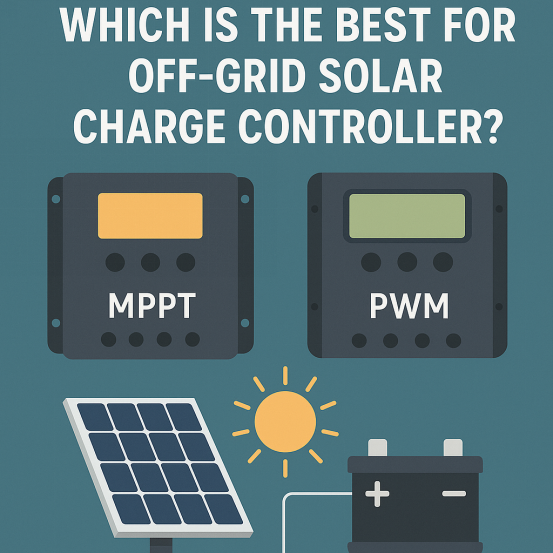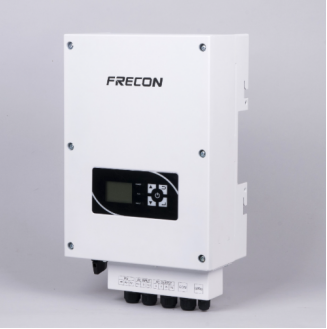MPPT vs PWM: Which is the Best for Off-Grid Solar Charge Controller?
Thinking about setting up an off-grid solar power system? You're on the right track to energy independence! But as you dive into the details, you'll quickly encounter a critical component: the solar charge controller. This device is the brain of your solar system, regulating the power flowing from your solar panels to your batteries, protecting them from overcharging, and ensuring efficient power delivery.
However, when it comes to choosing a charge controller, many users find themselves scratching their heads over a common dilemma: MPPT vs. PWM. Which one is truly the best fit for your off-grid solar inverter setup? Don't worry, you're not alone in this confusion, and we're here to break down the differences in a practical, easy-to-understand way. Let's get started!

PWM Solar Charge Controllers
PWM, or Pulse Width Modulation, charge controllers are a more traditional and often more budget-friendly option for off-grid solar systems. They've been a staple in the solar industry for years, especially for smaller setups.
How Does PWM Actually Work?
Assume that your solar panel is a water faucet and your battery a bucket. A PWM controller works by rapidly switching the connection between the solar panels and the battery on and off.
It's like quickly opening and closing the faucet. The "pulse width" refers to the duration the connection is "on" during each cycle. By varying this pulse width, the controller regulates the amount of current flowing into the battery.
When the battery needs more charge, the "on" time is longer; as it approaches full, the "on" time shortens to prevent overcharging. This method essentially "chops" the panel's output to match the battery's needs.
Voltage Matching
One crucial aspect of PWM controllers is that they operate by bringing the solar panel's voltage down to match the battery's voltage.
For example, if you have a 12V battery, the PWM controller will take the output from your solar panel (which might be around 18V Vmp, or voltage at maximum power) and effectively "clip" it to charge the 12V battery. This means any excess voltage from the panel above the battery's voltage is essentially wasted as heat.
This is why PWM controllers are most efficient when the solar panel's nominal voltage closely matches the battery bank's nominal voltage (e.g., a 12V panel for a 12V battery, or a 24V panel for a 24V battery).
The Advantages of a PWM Charge Controller
l Cost-Effective: PWM controllers are generally less expensive than their MPPT counterparts, making them a good choice for those on a tighter budget.
l Simplicity and Reliability: Their simpler design means fewer components, leading to higher reliability and less chance of malfunction. They are straightforward to install and operate.
l Good for Smaller Systems: For small-scale applications like RVs, small cabins, or basic lighting systems where the power demands are not high, PWM controllers can be perfectly adequate.
l Ideal for Matched Voltage Systems: They perform best when the solar panel's voltage is very close to the battery's voltage.
The Disadvantages of PWM Charge Controller
l Lower Efficiency: The primary drawback of PWM controllers is their lower efficiency, especially when there's a significant difference between the solar panel's voltage and the battery's voltage. They don't utilize the full power potential of the solar panel, as the excess voltage is not converted into usable current. This can lead to 10-30% less power harvest compared to MPPT controllers, particularly in certain conditions.
l Not Ideal for High Voltage Panels: If you're using higher voltage solar panels (e.g., 60-cell or 72-cell panels designed for grid-tied systems) with a lower voltage battery bank, a PWM controller will be very inefficient.
l Limited Flexibility: They offer less flexibility in system design, as panel and battery voltages need to be closely matched for optimal performance.
l Performance in Cold Weather: In colder temperatures, solar panels produce higher voltage. A PWM controller will still clip this excess voltage, leading to more wasted energy.
MPPT Solar Charge Controller
MPPT, or Maximum Power Point Tracking, charge controllers represent a more advanced and sophisticated approach to solar power management. They are designed to maximize the energy harvest from your solar panels, particularly in situations where efficiency is paramount.

FRECON PV580 Series Solar Pumping Inverter Adopts MPPT Algorithm
How MPPT Works
Unlike PWM controllers that simply chop the voltage, an MPPT controller continuously tracks and adjusts its input to find the "maximum power point" of the solar panel array.
Think of it like this: a solar panel's output isn't constant; it changes based on factors like sunlight intensity, temperature, and shading. There's a specific voltage and current combination at which the panel produces its absolute maximum power (its "sweet spot").
The MPPT controller uses a complex algorithm to constantly scan the panel's output and dynamically adjust its operating point to stay precisely at this maximum power point. It's akin to a smart gearshift in a car, always ensuring the engine runs at its most efficient RPM.
Voltage Conversion of MPPT Controller
The key differentiator for MPPT controllers is their ability to intelligently convert excess voltage into additional current.
If your solar panel generates, say, 36V, and your battery bank is 12V, a PWM controller would essentially discard the extra 24V. An MPPT controller, however, acts as a DC-to-DC converter. It takes that higher panel voltage, reduces it to the battery's voltage, and in the process, boosts the current. This means that if your panel is producing 36V at 5 amps, the MPPT controller can convert that into approximately 12V at 15 amps (ignoring conversion losses), effectively delivering significantly more power to your battery.
This voltage and current conversion is what makes MPPT controllers so much more efficient, especially with higher voltage panels.
The Advantages of MPPT Charge Controller
l Superior Efficiency: The most significant advantage of MPPT controllers is their ability to extract up to 10-30% more power from your solar panels compared to PWM controllers, especially in specific conditions. This translates directly to more energy for your batteries and loads.
l Versatile Panel Compatibility: MPPT controllers can work efficiently with a wide range of solar panel voltages. You can use higher voltage, more readily available, and often more cost-effective solar panels (like those designed for grid-tied systems) with lower voltage battery banks.
l Better Performance in Varying Conditions: They excel in situations with fluctuating light conditions (cloudy days, partial shading) and extreme temperatures (especially cold weather where panel voltage increases), as they constantly optimize power harvest.
l Ideal for Larger Systems: For larger off-grid solar systems with significant power demands, the increased efficiency of an MPPT controller can be crucial for meeting energy needs and can justify the higher upfront cost.
The Disadvantages of MPPT Charge Controller
l Higher Cost: MPPT controllers are more complex and contain more advanced electronics, which makes them significantly more expensive than PWM controllers.
l More Complex: Their advanced algorithms and features mean they can be more complex to set up and troubleshoot for beginners, though modern interfaces have made them more user-friendly.
l Less Critical for Small, Matched Systems: For very small systems where the panel voltage perfectly matches the battery voltage, the efficiency gains of an MPPT might not justify the additional cost.
l Heat Dissipation: Due to the power conversion process, MPPT controllers can generate more heat, requiring proper ventilation and potentially larger heat sinks, especially in larger units.
PWM vs MPPT Solar Charge Controller
To help you make an informed decision, let's put MPPT and PWM charge controllers side-by-side across key performance indicators:
PWM Charge Controller | MPPT Charge Controller | |
Efficiency | 70-80% efficient. Wastes excess panel voltage as heat. | 90-99% efficient. Converts excess voltage into current. |
System Size | Best for small systems (e.g., up to 200-300W). | Ideal for medium to large systems (e.g., 300W+). |
Panel Compatibility | Optimal when the panel's nominal voltage matches the battery's voltage (e.g., a 12V panel for a 12V battery). | Highly flexible; can use higher voltage panels with lower voltage battery banks. |
Complexity | Simpler design, easier to install and troubleshoot. | More complex electronics and algorithms. |
Performance in Cold/Cloudy/Partial Shade | Less efficient; voltage clipping leads to more wasted power in cold (higher voltage) conditions or with variable light. | Significantly better; actively tracks maximum power point, leading to higher energy harvest in challenging conditions. |
Making the Right Choice for Your Off-Grid System
The debate between MPPT and PWM charge controllers isn't about one being universally "better" than the other, but rather about which one is better suited for your specific off-grid solar application.
For industrial automation solutions, including advanced inverters and control systems that power efficient and reliable operations, we invite you to explore the innovative offerings from FRECON.





